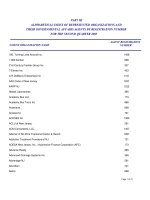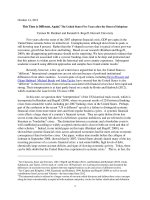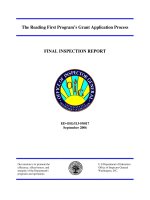Derailed by bankruptcy life after the reading railroad
Bạn đang xem bản rút gọn của tài liệu. Xem và tải ngay bản đầy đủ của tài liệu tại đây (10.7 MB, 158 trang )
R a i lroa ds Pa st a n d Pr e sen t
George M. Smerk and H. Roger Grant, editors
A list of books in the series appears at the end of this volume.
This book is a publication of
Indi a na U ni v er sit y Pr ess
Office of Scholarly Publishing
Herman B Wells Library 350
1320 East 10th Street
Bloomington, Indiana 47405 USA
iupress.indiana.edu
© 2015 by Howard H. Lewis
All rights reserved
No part of this book may be reproduced
or utilized in any form or by any means,
electronic or mechanical, including
photocopying and recording, or by any
information storage and retrieval system,
without permission in writing from the
publisher. The Association of American
University Presses’ Resolution on
Permissions constitutes the only exception to this prohibition.
The paper used in this publication
meets the minimum requirements of
the American National Standard for
Information Sciences–Permanence of
Paper for Printed Library Materials,
A NSI Z39.48–1992.
Manufactured in the
United States of America
Library of Congress
Cataloging-in-Publication Data
Lewis, Howard H., [date]
Derailed by bankruptcy : life after the
Reading Railroad / Howard H. Lewis.
pages cm. — (Railroads
past and present)
Includes bibliographical references
ISBN 978-0-253-01866-3 (cl : alk. paper)
— ISBN 978-0-253-01871-7 (eb) 1. Reading
Company. 2. Railroads—United States—
Finance. 3. Railroads—United States
—Management. 4. Bankruptcy—United
States. 5. Railroads and state—United
States. I. Title.
H E2791.R 27 L49 2016
385.06'57481—dc23
2015014883
1 2 3 4 5
20 19 18 17 16 15
To my family, my wife and children who bore with me
while I did the work which is the subject of this book.
CONTENTS
·
Foreword by John C. Spychalski ix
·
List of Abbreviations
·
List of Important Names xv
·
Introduction
1
The Age of Innocence 4
2
The Gathering Storm 18
3
A Time of Waiting 27
4
The Beginning 31
5
The Plot Thickens 42
6
Fear and Exhaustion 60
7
Detailed Case Preparation 68
8
The Times That Try Men’s Souls 77
9
The Rail Use Case: Ours and the Government’s 85
10
xiii
1
The Government’s Case 94
11
End Game 101
·
Epilogue
·
Notes 133
123
FOREWORD
Financial failure enveloped most of the rail network in the northeastern
United States and adjacent territory during the first half of the 1970s. By
1973, seven companies operating a total of 25,160 route miles of line in
this area were conducting business under bankruptcy law protection.
Historically, most railroads that suffered bankruptcy were returned to
solvency by so-called income-based reorganizations that reduced the
claims of security holders to levels that could be sustained by existing
and estimated future levels of revenue. However, the situation in 1973
was different. By then it had become apparent that the existing and foreseeable earnings of most if not all of the seven bankrupt companies had
fallen too low to support a reorganized structure of debt and equity securities of any magnitude. Consequently, liquidation of the companies’
assets and termination of most of the rail service in the Northeast became a real threat, thus posing the specter of serious collateral negative
economic consequences, locally, regionally, and nationally.
This grim scene sets the stage for attorney Howard H. Lewis’s autobiographical portrayal of his involvement with the bankruptcy proceedings of the Reading Company.1 As operator of 1,149 route miles of
line comprising 4.5 percent of the aforementioned total of 25,160 miles,
the Reading ranked third in size among its bankrupt counterparts. Although dwarfed by the 19,300-mile Penn Central Transportation Company, largest of the bankrupt carriers, the Reading served customers for
ix
x
for e wor d
whom continued availability of rail freight service was either absolutely
essential or highly preferable vis-à-vis motor freight service. In addition, the Reading operated heavily used commuter passenger service in
portions of the greater Philadelphia area, where diversion to private automobile usage was generally considered unacceptable from a net public
benefit perspective. Perhaps more importantly from the perspective of
rail industry competitive structure and rail freight service users, Reading formed a key link in connection with the Central of New Jersey (51
percent owned by Reading) and the Baltimore & Ohio portion of the
Chessie system that countered the post-1967 dominance of Penn Central
in the Northeast, particularly in the New York metropolitan area.
Three events beyond the Reading Company’s entry into bankruptcy
law protection (on December 28, 1971) were pivotal in setting the course
of professional and personal events that dominated Mr. Lewis’s life
through the almost decade-long progression of the Reading Company’s
bankruptcy case. First was the engagement of Mr. Lewis’s Philadelphiabased law firm, Obermayer, Rebmann, Maxwell and Hippel (ORM&H),
as counsel for the Reading’s bankruptcy proceedings. Second was
Mr. Lewis’s ascendance to partner in ORM&H in 1972. Third was an
evaluation of the performance of ORM&H’s work for the Reading from
the time of its start that Mr. Lewis performed at the request of the firm’s
managing partner. When presented with the finding that the Reading
needed more “hands-on legal representation,” the managing partner
immediately reassigned leadership of the firm’s Reading engagement to
Mr. Lewis. Mr. Lewis accepted the assignment, albeit after first protesting in vain that he “hated trains.” He anticipated that he could fulfill
it without a large commitment of time by forming a team of subordinates who, in consort with members of the Reading’s in-house legal staff,
would fully meet the company’s legal service needs.
Subsequent realities ultimately proved otherwise. In 1974, during
the early phase of his involvement with the Reading case, Mr. Lewis’s
other duties grew with his appointment as head of ORM&H’s Corporate
Department. That position carried the responsibility for assigning and
supervising work on all of the firm’s corporate law–related engagements.
Simultaneously, his Reading-related work continued on an upward trajectory. Constraints on available resources forced him to take and main-
for e wor d
xi
tain a direct hands-on leadership role throughout the duration of the
Reading case. The demand on his time and energy that it imposed rose to
a level that overshadowed his efforts on behalf of his other duties within
ORM&H well before the closure of the Reading Company’s bankruptcy
case in 1981. His personal time was also virtually eliminated. Regular
presence at family meals and other activities became impossible, communication with his children and spouse diminished, family vacations
were foregone, and in one instance almost all of a Christmas Day (1980)
was even consumed by his frantic effort to meet an urgent Reading case
work deadline in lieu of participating in long-standing traditional family
activities.
At the heart of the book are the author’s revelations about the many
conditions and problems he dealt with, the personalities he encountered,
and the actions he took throughout his years of work on the case. The
impossibility of bringing the Reading out of bankruptcy by means of an
income-based reorganization obviously made it impossible for the company to continue to exist as a provider of rail transport service. This left
only one objective for the company’s bankruptcy trustees and their legal
counsel to pursue: to obtain funds from the sale of the company’s assets
that in the aggregate would (hopefully) enable the settlement of creditors’ claims and the distribution of any residue funds to shareholders.
Howard Lewis’s “inside story” of how this objective was ably achieved
should be instructive and even entertaining for readers interested in
corporate bankruptcy law, railroad financial and managerial history, and
government transport policy.
John C. Spychalski
Professor Emeritus of Supply Chain Management
The Pennsylvania State University
ABBREVIATIONS
CERL
Chessie
Combined Erie, Reading, and Lehigh
Valley Railroads (existed only in the
mind of the US government)
Chesapeake and Ohio Railway and affiliated
companies, including the Baltimore and Ohio
Railroad and the Western Maryland Railway
CNJ
Central Railroad of New Jersey
CMV
constitutional minimum value
Conrail
CUE
Consolidated Rail Corporation
compensable unconstitutional erosion
Erie
Erie Lackawanna Railway
FRA
Federal Railroad Administration
ICC
Interstate Commerce Commission
IPO
initial public offering
NRO
net railway operating income
xiii
xiv
A bbr e v i at ions
OCLDD
P&E
PG&N
original cost less depreciation and deterioration
Peoria and Eastern Railway
Philadelphia, Germantown and Norristown Railroad
Rail Act
Regional Rail Reorganization Act of 1973
RCNL
reproduction cost new less depreciation
Reading
SEPTA
USRA
Reading Railroad
Southeastern Pennsylvania Transportation Authority
United States Railway Association
IMPORTANT NAMES
Arthur Baylis provided testimony as to the
valuation of the Reading Railroad
Isabel Benham valuation expert for the Reading Railroad
Charles Bertrand
president of the Reading Railroad
John Brennan chief financial officer for the Reading Railroad
John Bunting CEO of First Pennsylvania Bank
Joseph (Joe) L. Castle trustee of the Reading Railroad
(succeeding Richardson Dilworth upon Dilworth’s death)
Lloyd Cutter lawyer representing the Penn Central Railroad
Richardson (Dick) Dilworth
trustee of the Reading Railroad
William (Bill) Dimeling attorney for the Reading Railroad
William (Bill) Ditter judge in charge of the
Reading Railroad’s reorganization
Richard (Dick) Duzak accountant with Peat Marwick
Herbert A. Fogel mentor
xv
xvi
I m porta n t Na m e s
Lockwood (Lock) L. Fogg Jr. special counsel and later
secretary and general counsel to the Reading Company
John Fowler
attorney for the Reading Company
Jim Frick former Reading Railroad employee (returned
to help tie up loose ends after conveyance)
Henry Friendly chief judge of special court
William Fuchs managing partner of Obermayer,
Rebmann, Maxwell and Hippel
Jim Gallagher accountant with Peat Marwick
Alfred (Bill) W. Hesse senior vice president and general
counsel, and later president, of the Reading Company
Tom Keyser chief financial officer of the
Reading Railroad after John Brennan
Andrew (Drew) L. Lewis trustee of the Reading
Railroad and later secretary of transportation
Bernard (Bernie) G. Meltzer real estate broker and
local columnist and radio personality
Christine Nethesheim attorney for the United
States Railway Association
Hugh Scott
US senator
Doug Segal
attorney for the United States Railway Association
Larry Shiekman partner at Pepper, Hamilton
& Scheetz, representing Conrail
James (Jim) Alan Sox assistant to Howard Lewis and
former law clerk of Judge William Ditter
I m porta n t Na m e s
Grant Sprecher head of the Litigation Department at
Obermayer, Rebmann, Maxwell and Hippel
Roszel Thomsen judge of special court formed to
oversee the railroad’s reorganization
Stuart Warden former Reading Railroad employee
(returned to help tie up loose ends after conveyance)
Harris Weinstein attorney representing
Penn Central’s passenger case
John Wisdom judge of special court and
Fifth Circuit Court of Appeals
xvii
Introduction
I am, by nature and inclination, lazy. Like many, I came to the practice of
law with no great vocation but rather for its place as a refuge for the humanistically educated and verbally inclined. I had small talent and even
less training. I graduated from Harvard Law School without distinction
and accepted an offer from the firm for which I had clerked. After six and
a half years, it became apparent to me that I needed to move on.
I was then hired by the law firm of Obermayer, Rebmann, Maxwell
and Hippel in December 1969 and became a partner in 1972. I was appointed head of the Corporate Department in 1974. Under the firm’s culture, as department head I had the responsibility, or better the privilege,
of assigning and supervising all corporate work as it developed, which
meant I could keep the best and most lucrative work for myself while
assigning the less rewarding cases to others. I had it made. Then there
came the Reading.
For those of you who have forgotten your Monopoly, the Reading is,
or was, a medium-sized bridge carrier centered around Reading, Pennsylvania, with lines extending south to Wilmington, Delaware, northwest to Newberry Junction (Williamsport), Pennsylvania, west to Harrisburg, Pennsylvania, northeast to Newark, New Jersey (in partnership
with the Central Railroad of New Jersey), and east to Philadelphia and,
in combination with Penn Central, Atlantic City.
The Reading Company had a glorious history.1 It was once the largest corporation in the United States and focused on carrying anthracite,
1
2
Der a i l e d by Ba n k ru p tc y
or hard coal, from the mines of Schuylkill County, whose county seat is
located in Pottsville, Pennsylvania, to the port of Philadelphia for transshipment up and down the east coast and, to a lesser extent, Europe.
It was a highly integrated vertical monopoly, building most of its own
locomotives and some cars at its shop in Reading; it also owned much
of the coal it shipped until it was forced to divest itself of the coal mines
as a result of an antitrust decision in 1923, spinning them off to its shareholders in a company known as the Reading Anthracite Coal Company.
It had a violent history of labor warfare, culminating in the prosecution
and execution of the Molly Maguires at the hands of its then president,
Franklin B. Gowen. Its financial history was no less stormy; it suffered
through several bankruptcies in the late nineteenth and early twentieth
centuries, which it solved in the traditional manner of railroad bankruptcies by giving its bondholders and other creditors stock for their debt.
Finally, it figured prominently in the eastern railroad wars in the first
half of the twentieth century between the Pennsylvania Railroad and the
New York Central. If it could be said in the period before the New Deal
that the Pennsylvania Railroad owned the Pennsylvania legislature and
the Pennsylvania Supreme Court, at least the Reading owned Schuylkill
County.
All of this past glory had long faded by the time I became involved
in the Reading’s affairs in 1972. At that time, 51 percent of its stock was
owned by the Chessie, an amalgam of the Chesapeake and Ohio, Baltimore and Ohio, Western Maryland, and a few other minor roads. It
served as Chessie’s access to markets in Philadelphia through its main
route from its connection with the Western Maryland at Lurgan (which
is a cornfield), to Allentown, to connections with the Lehigh Valley and
Delaware and Hudson, and through there to markets in New York and
New England. It also went up the Delaware River to a connection with
the Central Railroad of New Jersey (which Reading controlled through
stock ownership) and then to the so-called Chemical Coast, that line of
drug and chemical industries in northern and central New Jersey which
produces some of the most lucrative as well as hazardous rail car loads in
the country; out of all its lines, its single most profitable move was transshipping ore from the port of Philadelphia to Bethlehem Steel’s plant
at Bethlehem, Pennsylvania. It was essentially an arm of the Chessie
I n t roduct ion
3
acquired cheaply through a controlling, but less than total, stock ownership, and served as an important chip in Chessie’s struggle to compete
with what was then the giant Penn Central, a merger of the Pennsylvania
and New York Central roads.
This book is a memoir and not a history. To attempt a history would
require a great deal of research in sources outside my own notes, written presentations, and memory. This work is primarily a record of my
experience, not an analysis of the transformation of the rail industry,
and as such, it does not pretend to be a complete objective account of
what happened.
1
The Age of Innocence
My first experience with the Reading was learning in 1971 that we at
ORM&H would be counsel for it in its recently filed reorganization,
and wasn’t that exciting? It didn’t really excite me. From what I casually
learned about the case, it seemed to be a litigation, not a corporate matter,
and I expected to have little if anything to do with it.
In the winter of 1972–1973, my mentor, Herbert A. Fogel, who was in
charge of the Reading account, decided to ascend to the federal bench,
and shortly thereafter my managing partner, William Fuchs, asked me
to look into the representation to make sure that our client was being
serviced adequately. I dutifully reported that I sensed some unhappiness
in my short meetings with Reading’s staff and Drew Lewis, its active
trustee, and that their affairs could stand some more hands-on legal
representation. He turned to me and said, “OK, you’re it.”
“But Bill,” I replied, “I hate trains.”
“You’ll learn to love them, Howard. Besides, you have enough independent means to be able to afford a large commitment of your time at
low rates to something that will end one day with no follow-up.”
“All right, I’ll try, but only until I can find someone else.”
At the time I thought I could go in and organize a team consisting of
a corporate associate, a government liaison, and a litigator, all of whom
would devote small amounts of their time to specific problems, while the
Reading, under its own legal staff, would run itself and I could become
4









